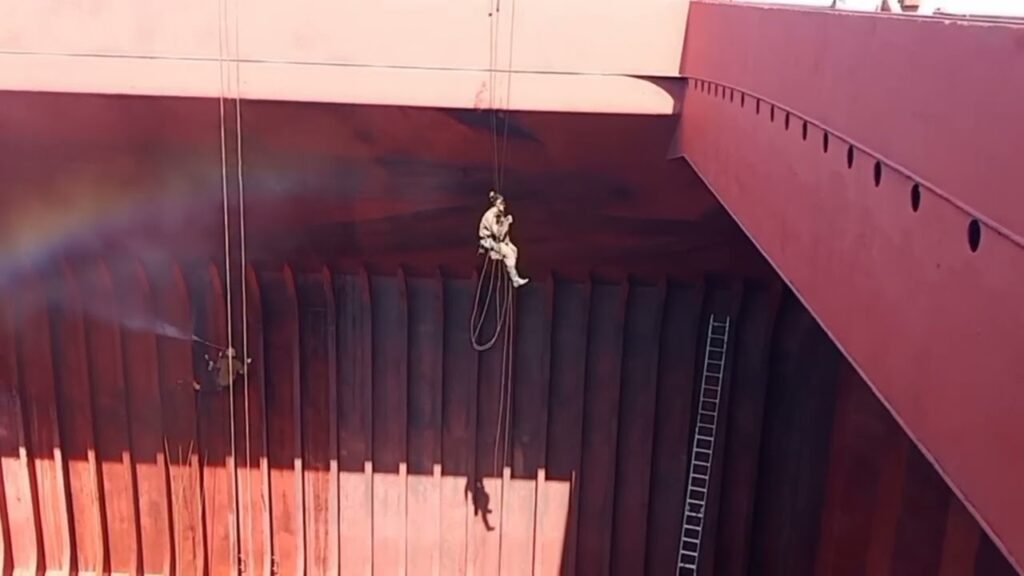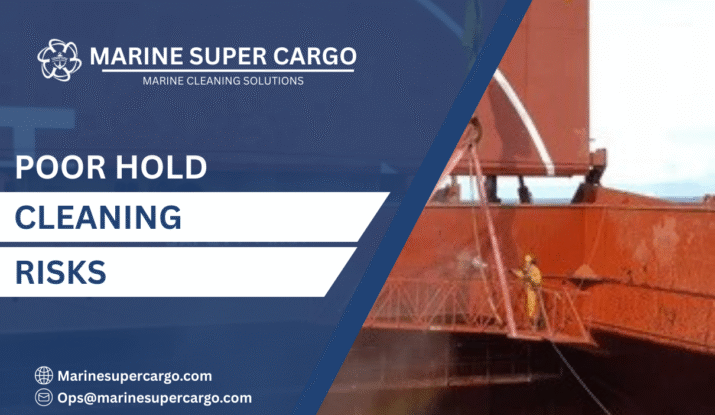Poor hold cleaning risks represent one of the most significant operational threats facing bulk carrier operations in today’s competitive maritime industry. These poor hold cleaning risks encompass financial losses, regulatory violations, and operational disruptions that can devastate shipping companies. Understanding poor hold cleaning risks enables vessel operators to implement effective prevention strategies.
Marine Super Cargo has extensively documented poor hold cleaning risks across various bulk carrier operations, revealing the substantial impact these issues have on vessel profitability and operational efficiency. The consequences of poor hold cleaning risks extend far beyond immediate cleaning costs, affecting long-term commercial relationships and regulatory standing.
Cargo Contamination Consequences Poor hold cleaning risks
Cross-Contamination Between Cargo Types
Cross-contamination represents the most immediate consequence of inadequate cleaning procedures between different cargo types. Poor hold cleaning risks Residual materials from previous voyages can render subsequent cargo loads unsuitable for their intended purpose, creating substantial financial losses.
Coal dust contaminating grain shipments makes the entire cargo unsuitable for human consumption, resulting in total cargo rejection. Similarly, chemical fertilizer residues can contaminate food-grade commodities, triggering extensive cleaning and disposal costs.
Quality Degradation Issues
Poor cleaning practices lead to gradual cargo quality degradation that may not become apparent until discharge operations commence. Poor hold cleaning risks This insidious contamination creates complex liability issues between shipowners, charterers, and cargo receivers.
Organic matter remaining in holds can promote bacterial growth and pest infestations during long voyages. These biological contaminants compromise cargo quality while creating health hazards for crew members and stevedores.
Metal corrosion products from inadequately cleaned holds can discolor and contaminate sensitive cargoes like grain and sugar. This contamination often goes undetected until cargo reaches its final destination.
Regulatory Non-Compliance
Contaminated cargoes frequently violate food safety regulations and import standards in destination countries. Poor hold cleaning risks These violations can trigger cargo quarantine, extensive testing procedures, and potential destruction of entire shipments.
Marine Super Cargo has observed numerous cases where poor cleaning led to regulatory violations resulting in cargo rejection and vessel blacklisting from certain trade routes.
International phytosanitary requirements for agricultural commodities become impossible to meet when holds contain pest residues or organic contamination from previous cargoes.

Financial Claims and Insurance Issues
Cargo Damage Claims
Cargo contamination inevitably leads to substantial damage claims against vessel operators and their insurers. These claims often exceed the value of cleaning costs by orders of magnitude, making prevention economically essential.
Legal proceedings for cargo contamination can extend for years, creating ongoing financial uncertainty and damaging commercial relationships. Poor hold cleaning risks Expert witness fees, legal costs, and eventual settlements frequently reach six-figure amounts.
Multiple parties may pursue claims simultaneously, including charterers, cargo owners, receivers, and end users affected by contaminated products. This multiplicity of claims compounds financial exposure significantly.
Insurance Coverage Limitations
Marine insurance policies often contain exclusions or limitations regarding cargo contamination claims arising from inadequate vessel maintenance or cleaning procedures. These limitations can leave operators exposed to substantial uninsured losses.
Underwriters increasingly scrutinize vessel cleaning procedures and maintenance records when evaluating claims. Poor hold cleaning risks Poor documentation or inadequate cleaning protocols can void coverage entirely.
Repeated contamination incidents may result in policy non-renewal or significantly increased premiums, affecting long-term operational viability and competitive positioning.
General Average Contributions
Severe contamination incidents may trigger general average declarations when cargo must be discharged at intermediate ports for cleaning or disposal. All cargo interests become liable for their proportionate share of these extraordinary expenses.
General average adjusters carefully examine cleaning procedures and vessel maintenance records to determine liability allocation between vessel and cargo interests.
Vessel Detention and Operational Disruptions
Port State Control Interventions
Port state control authorities regularly inspect bulk carriers for compliance with cleaning and cargo handling standards. Substandard conditions can result in immediate vessel detention until deficiencies are corrected.
Detention periods vary based on contamination severity and required remedial actions. Poor hold cleaning risks Extended detentions can last weeks, creating substantial opportunity costs and charter party complications.
Port authorities may require specialized cleaning services, certified waste disposal, and independent surveys before releasing detained vessels. These requirements often exceed standard cleaning procedures significantly.
Cargo Loading Delays
Inadequately cleaned holds frequently require additional preparation before cargo loading can commence. Poor hold cleaning risks These delays affect vessel schedules and may trigger demurrage claims from charterers.
Stevedoring operations may cease immediately upon discovering contaminated hold conditions. Restart procedures require complete cleaning verification and often independent surveyor approval.
Multiple cleaning attempts may be necessary when initial efforts prove inadequate. Each iteration extends delays and increases costs while affecting subsequent voyage schedules.
Commercial Reputation Damage
Repeated incidents involving poor hold cleaning create lasting reputation damage affecting future charter opportunities and commercial relationships. Poor hold cleaning risks Major commodity traders maintain blacklists of vessels with contamination histories.
Marine Super Cargo emphasizes that reputation recovery following serious contamination incidents can take years and requires consistent demonstration of improved cleaning standards.
Social media and industry publications quickly spread news of contamination incidents, amplifying reputation damage beyond immediate commercial circles.
Regulatory and Legal Consequences
Environmental Violations
Poor cleaning practices often lead to improper waste disposal and environmental violations. Contaminated wash water discharge violates MARPOL regulations and can trigger substantial penalties.
Port authorities may pursue criminal charges for serious environmental violations resulting from inadequate cleaning waste management procedures.
Environmental cleanup costs following contamination incidents can reach millions of dollars, particularly when sensitive marine ecosystems are affected.
Crew Safety and Health Issues
Contaminated holds create health hazards for crew members performing subsequent cleaning operations. Toxic residues may require specialized protective equipment and trained personnel. Poor hold cleaning risks
Occupational safety violations can result in crew injury claims, regulatory penalties, and potential criminal liability for vessel operators.
Some contamination requires professional hazardous material handling procedures that exceed normal crew capabilities and training levels.
Prevention Strategies and Risk Mitigation
Comprehensive Cleaning Protocols
Effective prevention requires detailed cleaning protocols tailored to specific cargo sequences and contamination risks. These protocols must address all areas from tank tops to bilge wells.
Regular equipment maintenance ensures cleaning systems operate effectively throughout vessel service life. Poor hold cleaning risks Inadequate equipment performance directly contributes to cleaning failures.
Crew training programs must emphasize contamination risks and proper cleaning procedures for different cargo types. Regular refresher training helps maintain awareness and performance standards.
Documentation and Quality Control
Comprehensive documentation provides evidence of proper cleaning procedures while supporting insurance claims and regulatory compliance efforts. Digital systems improve documentation accuracy and accessibility.
Independent surveys verify cleaning effectiveness and provide objective evidence of compliance with charter party and regulatory requirements.
Quality control procedures should include random inspections and testing to verify cleaning effectiveness before cargo operations commence.
Technology Solutions and Monitoring
Advanced Cleaning Equipment
Modern cleaning systems provide more effective contamination removal while reducing water consumption and waste generation. Investment in proper equipment pays dividends through reduced contamination risks.
Automated monitoring systems can detect cleaning effectiveness and alert operators to potential problems before contamination occurs.
Digital Documentation Systems
Electronic documentation systems provide comprehensive audit trails while improving information accessibility for all stakeholders. These systems support both operational efficiency and regulatory compliance.
Real-time monitoring capabilities enable proactive intervention when cleaning standards aren’t met, preventing contamination incidents before they occur.
Conclusion
The risks of poor hold cleaning extend far beyond immediate cleaning costs, encompassing cargo contamination, financial claims, vessel detentions, and lasting reputation damage. Understanding these risks enables bulk carrier operators to implement effective prevention strategies that protect both commercial interests and operational efficiency.
Marine Super Cargo remains committed to helping vessel operators minimize these risks through comprehensive cleaning solutions and professional expertise. Investment in proper cleaning procedures, equipment, and training provides essential protection against the severe consequences of inadequate hold maintenance.
The maritime industry’s increasing focus on cargo quality and environmental protection makes effective hold cleaning more critical than ever. Operators who prioritize cleaning excellence position themselves for long-term success while avoiding the devastating consequences of contamination incidents.
Frequently Asked Questions
1. What are the most common causes of cargo contamination in bulk carriers?
Common causes include inadequate cleaning between different cargo types, poor waste removal from previous cargoes, contaminated cleaning equipment, and insufficient crew training. Residual coal, grain, or chemical traces frequently contaminate subsequent loads.
2. How much can cargo contamination claims cost vessel operators?
Contamination claims often range from hundreds of thousands to millions of dollars, depending on cargo value and contamination extent. Legal costs, expert fees, and operational delays significantly compound total expenses beyond direct cargo replacement costs.
3. What regulatory penalties can result from poor hold cleaning?
Penalties include vessel detention, substantial fines, environmental cleanup costs, and potential criminal charges. Port authorities may ban vessels from future operations, while flag states can impose operational restrictions affecting global trading capabilities.
4. How long do vessel detentions typically last for cleaning violations?
Detention periods vary from days to weeks depending on contamination severity and required remedial actions. Complex cases requiring specialized cleaning, waste disposal, and multiple inspections can extend detentions significantly.
5. Can insurance policies cover cargo contamination claims from poor cleaning?
Coverage depends on policy terms and contamination circumstances. Many policies exclude claims from inadequate maintenance or negligent cleaning procedures. Operators should review coverage carefully and maintain proper documentation to support potential claims.


